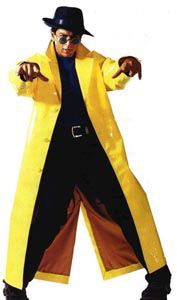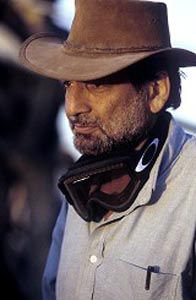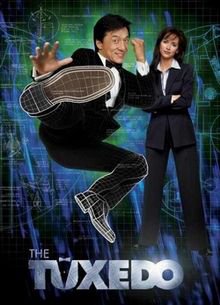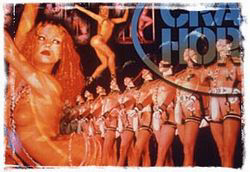Arts
Raising The Asian Flag

Asian filmmakers rebel against Hollywood.
|
There is a remarkable scene in Nikhil Advani’s film Kal Ho Na Ho (2003), in which Aman (the lead actor Shah Rukh Khan) tells Jennifer (Jaya Bhaduri), playing the role of an Indian restaurateur in New York, who is losing business to her competitor, a Chinese restaurant: “Look at the Chinese restaurant across the road. Why are they successful? The Chinese are successful because they carry their culture with themselves wherever they go.” Soon, the star-spangled American flag is replaced by a tiranga (India’s national flag), the interiors of the failing Indian restaurant are revamped, and lo and behold, business picks up in no time.
I was reminded of this scene when I read the recent remarks of Hong Kong star Jackie Chan: “Asians should unite against American cinema.” The report came from Mumbai, India’s film capital, where Jackie was promoting his latest film, The Myth, co-starring Indian actress Mallika Sherawat. The report exhorted Asians: “Unite against U.S. movies, you have nothing to lose but your culture.” Hollywood movies are eroding the culture of Asian countries, Chan reportedly told The Times of India. He asked why did we need to ape American culture. “I see an Indian saying, ‘Yo Man!,’ but that’s not what Asians are about. Cinema reflects culture and there is no harm in adapting technology, but not at the cost of losing your originality,” he said. This morsel of moralizing, especially coming from an actor who had starred and benefited from Hollywood blockbusters (Shanghai Noon, Shanghai Knights, Rush Hour I & II, The Medallion, Around the World in 80 Days) in the recent years, may sound just a little odd. Not that Chan can be accused of compromising Asian values in his Hollywood avatars. Interestingly, Chan is not alone to harp on the changing mores of Asian societies, especially under the influence of the Hollywood movie machine. Iranian auteur Abbas Kiorastami, the jury chairman at this year’s Pusan International Film Festival, voiced a similar concern at a press gathering in South Korea: “You can see the trend for films all over the world to become more and more similar.” Kiorastami, Iranian filmmaker par excellence, exhorted Asian filmmakers to make films that reflected different cultures, and not just blindly copying the Hollywood formula films for commercial gain. “Asian filmmakers now are forgetting their cultural identities and becoming too Americanized,” he added. “I want Asian films,” the 65-year-old filmmaker said, “to be Asian. It’s important to express your own ideas. It’s sad that films are becoming so commercial and so similar.” They are most concerned by Americanization of Asian films. One may agree or disagree with Chan and Kiorastami, but their stand begs an exploration of the two value systems (of the East and the West), and whether this dichotomy of values could still hold water in these rapidly globalizing times. So, what are the Asian values? The major Asian values, in the words of Singaporean scholar Kishore Mahbubani (Can Asians Think? 2004), are: “attachment to the family as an institution, deference to societal interests, thrift, conservatism in social mores, and respect for authority.” On the other hand, the strength of the Western values are: “the emphasis on individual achievement, political and economic freedom, respect for the rule of law as well as for key national institutions.”
But values, Eastern or Western, cannot be discussed without a reference to the socio-economic conditions of a society. Historically speaking, the world has been dominated by the Western civilization for the past two centuries. The West’s technological innovations and economic power first colonized and then mesmerized Asians. Until a few decades ago, every Asian desired to go to London or New York where the streets were paved with gold. Then came the Asian economic miracle. First Japan, then the South East Asian tigers (Korea, Taiwan, Singapore and Hong Kong), and now China and India. Despite some hiccups, the economic success of these Asian countries have reawakened the dream of an Asian century. And cinema, a tool in the hands of dream merchants for the projection of the masses’ conscious and unconscious desires on the larger than life screen – originally a Western invention – assumes a greater role in defining the zeitgeist of an era. And therein lies the irony. As J. M. Roberts noted in his 1985 work, The Triumph of the West: “Here lies the deepest irony of post-Western history: it is so often in the name of Western values that the West is rejected and it is always with its skills and tools that its grasp is shaken off.” The desire for the reassertion of the Asian values, expressed by filmmakers like Chan and Kiorastami, represent a complex set of motives and aspirations. It reflects a deep-rooted desire to reconnect with their historical past. This connection had been ruptured both by colonial rule and by the subsequent domination of the world by a Western worldview. The recent Asian successes – Crouching Tiger, Hidden Dragon, The House of Flying Daggers, The Myth, Dilwale Dulhaniya Le Jayenge, Lagaan, Kuchh Kuchh Hota Hai, Kabhi Khushi Kabhi Gham, Kal Ho Na Ho, just to name a few – corroborate this view. These films either hark back to a past that does not exist anymore or they are cinematic essays trying to find the right balance in the current state of affairs – for a generation that is open to the “flat world” of a technologically interconnected universe, immigration and yet rooted in and conscious of the cultures of their ancestors. Remember the England-returned bhajan singing Rani Mukherjee in Kuchh Kuchh Hota Hai (1998)? In the Nasreen Munni Kabir-helmed documentary film, The Inner and Outer World of Shah Rukh Khan (2005), the Indian superstar’s legions of fans, in UK, US, and Canada, mostly immigrant Indians, are shown idolizing him because he seems to represent the best of Indian culture with the modern day élan of a cool, resurgent India. Some fans say that his films are strong in family values. His films, they said, give them what most American films cannot. “He could play a brother, a friend, a lover, and a husband with equal charm,” says one of his American female fans in the film. It is not surprising the Shah Rukh Khan’s rise as India’s international matinee idol has been concurrent with India’s post-liberalization economic boom.
The concerns expressed by Chan and Kiorastami are especially relevant to Asian filmmakers who are trying to blaze a new trail, overwhelmed by the gloss and sassiness of Hollywood’s flicks. Getting carried away a little, that’s when things go wrong with a Sanjay Gupta’s Kaante (2002; based on Reservoir Dogs) or a Jingle Ma’s Seoul Raiders (2005). In November this year, when Shekhar Kapur was in Singapore, he said that Singapore had the potential to become the next Hollywood. By this, I am sure, he meant that Singapore had the necessary wherewithal – the money, the infrastructure, a talented multilingual and multicultural pool of creative people – to emerge as the next Hollywood, and not as a place to facilitate a Hollywood-like standardization as a creative goal. Asian creativity has to spin its own kind of storytelling. Kapur had written in 2002: “There is a profound cultural difference between Asian philosophies and western philosophies: eastern storytelling is mythic, and western storytelling is less so.” The key question, therefore, is whether Asian filmmakers will be able to develop the right blend of values that will both preserve some of the traditional strengths of Asian values with the strengths of Western values. Therein lies the challenge. In early December 2005, when the Crazy Horse Paris started its shows in Singapore, a topless dance revue, it attracted a lot of criticism in the media. Letter writers and commentators accused the show “of exploiting women, being chauvinistic, archaic, outdated, immoral, sleazy, a threat to marriages and a poor example to children.” “Soft porn has finally landed here…officially,” said a Singaporean blogger. Commenting on these reactions, humor writer Neil Humphreys quipped: “I am sure it also contributes to global warming and the hole in the ozone layer.” Questions were being asked: Is Crazy Horse Paris a step forward or a step backwards for Singapore? At the heart of this controversy is the debate over “Asian values.” Since the rise of the Asia’s tiger economies (Korea, Taiwan, Hong Kong and Singapore) in the last quarter of the twentieth century, the “Asian values” debate has been centre-stage. The main thesis of Asian values is the appealing notion that Asians sacrificed individual aspirations for the greater good of society. Historically, the unusual economic growth experienced within East Asian countries pushed the socio-political structures of these countries under the spotlight. The success of these countries as well the economic awakening of giants like China and India, coupled with the friction that has resulted over “trade protectionism, economic conditionality, democracy and human rights” have made the “Asian values” debate political.
“Asian values’ is a fundamentally racist term,” says Fulbright scholar Ravi Veloo, managing director of Media Campus, Singapore. “Riding on rising Asian economic power the way a parasite rides on a healthy host, infects the Asian mind with a sense of false psychological well-being by looking at the former colonial masters in a negative light, and presenting good values as ‘Asian,’ ignoring the rest of the world where such values are embraced. I am embarrassed for those who use this term,” he adds. Veloo is referring to the idea of “Asian values” invariably being seen in the context of an East-West dichotomy, where “Asian values” celebrate the community over individualism, the family, frugality, respect for learning, hard work, public duty, teamwork, in contrast to the perceived breakdown of the family, decadence, hedonism, excessive individualism, lack of teamwork, fecklessness, and ill discipline in the West. “One commonly cited example of Asian values is close-knit families,” says Veloo. “But what about African and Latin American societies where families are also closely knit. Are they Asian societies?” he asks. He is also not comfortable with the allegation that the West is inherently morally debased. “Another common derisory example of Western values is the overt sexuality of westerners, as if India did not invent the Kama Sutra,” he says. He adds: “We also ignore the fact that large conservative groups of Americans make up the Bible belt who reject the so-called Hollywood values. By the way, no church in the world puts up sexually suggestive figures in places of worship, unlike certain Asian places of worship.” Finally, he asks, “In which part of the world is AIDS, transmitted primarily by sex, the biggest rising problem? How could this even happen in one of the homes of ‘Asian values’?”
The debate has taken political ocvertones with leaders such as Mahathir bin Mohamad, former prime minister of Malaysia and Lee Kuan Yew, the former prime minister of Singapore, exhorting for a renaissance of “Asian values,” in concert with their economic rise,, in contrast to the socially and economically deteriorating Western societies. “The Asian values debate was something Lee Kuan Yew, forced into the public domain in the 1980s,” says P.N. Balji, former editor of Today and The New Paper. “He framed the debate with Chinese philosopher Confucius as the pillar. Mr Lee Kuan Yew’s main fear was the loss of respect for elders (read the authorities) as the onslaught of Western values through Hollywood movies and American lifestyle gained prominence.” After the Asian financial crisis and the new wave of globalization aided by information technology, says Balji, “the preaching of values disappeared. Today, Singapore is even more plugged into the Western world than ever before. Differentiating between eastern and western values makes no economic sense. Singapore realizes that too, like many other ideological debates here, has been dumped into the dustbin of politics.” Ameerali Abdeali, a bureaucrat and community leader in Singapore, says: “Both Western and Eastern cultures have been influenced by historical events and media exposure. Values are a subset of these cultures. Western and Asian values may differ considerably, for example, values such as filial piety and discipline are associated with Eastern culture and materialism and individualism are largely regarded as Western value. However, it would be misleading to suggest that one set of values is inherently superior to the other. Both have their strengths and weaknesses. So I am not for the outright rejection of one value system over the other.” Crazy Horse Paris seems to be playing pretty well as Singaporeans loosen up. |
||||||||





